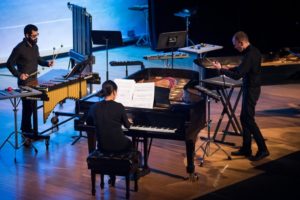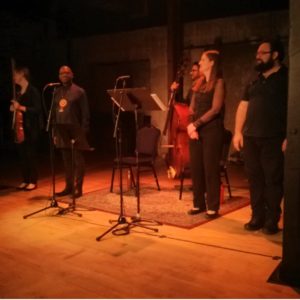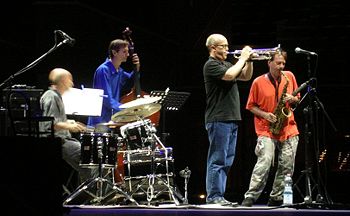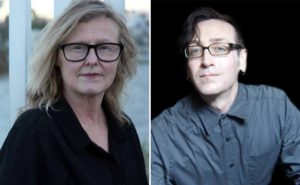Hard to believe that the venerable Bang on a Can Marathon began as a one day concert on Mother’s Day 1987 in a SoHo art gallery. That’s 30 years ago for those of you keeping score at home. Since then it has grown into a multi-faceted performing arts organization with a broad range of year-round international activities that have had a profound influence on New Music around the world. As the NYTimes puts it: “The current universe of do-it-yourself concert series, genre-flouting festivals, composer-owned record labels and amplified, electric-guitar-driven compositional idioms would probably not exist without their pioneering example. The Bang on a Can Marathon, the organization’s sprawling, exuberant annual mixtape love letter to its many admirers, has been widely emulated…”
The 30th Anniversary Bang on a Can Marathon will be presented for the first time at Brooklyn Museum on Saturday, May 6, 2017 from 2-10pm in the Museum’s Beaux-Arts Court. As always, the event will be a mix of boundary-busting music from around the corner and around the world featuring eight hours of rare performances by some of the most innovative pioneering composers and musicians on the planet.
his year the Marathon includes music from such diverse places as Iraq (Amir ElSaffar and his Two Rivers Ensemble), India (Brooklyn Raga Massive), Morocco (Innov Gnawa), and the Caribbean (Pan in Motion and Kendall Williams), plus Bang on a Can co-founder and Pulitzer Prize-winning composer Julia Wolfe’s folk ballad Steel Hammer, based on over 200 versions of the John Henry ballad, a quintessential American legend of the laborers that worked the railroad.
In a statement, co-founders Michael Gordon, David Lang, and Julia Wolfe say, “Thirty years ago we started dreaming of the world we wanted to live in. It would be a kind of utopia for music: all the boundaries between composers would come down, all the boundaries between genres would come down, all the boundaries between musicians and audience would come down. Then we started trying to build it. Building a utopia is a political act – it pushes people to change. It is also an act of resistance to the things that keep us apart.”
The Marathon is also part of A Year of Yes: Reimagining Feminism at the Brooklyn Museum, a yearlong project that celebrates the 10th anniversary of the Elizabeth A. Sackler Center for Feminist Art through ten diverse exhibitions and an extensive calendar of related public programs. Women artists on this year’s marathon include music and/or performances by Meredith Monk, Julia Wolfe, Joan La Barbara, Carla Kihlstedt, Caroline Shaw, Kaki King, Kim Deal, Merrill Garbus (tUnE-yArDs), Women’s Raga Massive, and many more.
Highlights of the 2017 30th Anniversary Bang on a Can Marathon include:
- Oberlin Contemporary Music Ensemble directed by Timothy Weiss, playing Dutch composer Louis Andriessen’s hard-driving Platonic masterpiece De Staat (“The Republic”), written as a commentary on the debate about the relation of music to politics
- Brooklyn’s mesmerizing steel pan band Pan in Motion playing music by composer Kendall Williams
- Hindustani all-stars Brooklyn Raga Massive paying special tribute to the Brooklyn’s Museum’s A Year of Yes with an all-female ensemble Women’s Raga Massive
- Bang on a Can co-founder and Pulitzer Prize-winning composer Julia Wolfe’s folk ballad Steel Hammer, based on over 200 versions of the John Henry ballad, a quintessential American legend of the laborers that worked the railroad
- Renowned saxophonist, composer, painter, and poet Oliver Lake, co-founder of the internationally acclaimed World Saxophone Quartet
- Joan La Barbara’s A Murmuration for Chibok, which honors and keeps in the present over 250 school girls abducted in Chibok, Nigeria by Boko Haram in 2014, performed by the award-winning Young People’s Chorus of NYC, led by Francisco Nuñez
- New York’s legendary and inspirational composer-singer Meredith Monk leading the women of her acclaimed vocal ensemble in a set of shimmering a cappella pieces from her work-in-progress, Cellular Songs
- Bang on a Can’s extreme mobile ensemble Asphalt Orchestra performing music by Merrill Garbus/ tUnE-yArDs, Kim Deal/Pixies, and more
- The song-spinning duo Rabbit Rabbit, Carla Kihlstedt and Matthias Bossi
- A rare solo set by Pulitzer-prize winning composer-singer-violinist Caroline Shaw
- The distinctive and exceptional indie-guitarist Kaki King
- The ambient music world of Laraaji
- The Moroccan grooves of Brooklyn’s Innov Gnawa, exploring Mococco’s venerable gnawa music tradition
- Amir ElSaffar’s Two Rivers Ensemble, an all-star sextet of jazz and Middle Eastern musicians that blends maqam music of Iraq and contemporary jazz
- The New York premiere of Bang on a Can co-founder Michael Gordon’s No Anthem, premiered by Ensemble Modern in 2015
- The Brooklyn premiere of David Lang’s Just, featured in last year’s Oscar nominated film Youth by Paolo Sorrentino
- And Bang on a Can’s social engagement wing Found Sound Nation’s Street Studio, a mobile recording studio equipped for passersby and Marathon musicians alike to spontaneously create and record original music
2017 BANG ON A CAN MARATHON SCHEDULE (subject to change):




 The Stone, the landmark non-profit performance space founded in 2005 by John Zorn and dedicated to the experimental and avant-garde, will move to The Glass Box Theater at Arnhold Hall on 55 West 13th Street, in the heart of New York’s Greenwich Village. Arnhold Hall is the performing arts hub for The New School, housing the three performing arts schools of The College of Performing Arts: Mannes School of Music, The New School for Drama, and The New School for Jazz and Contemporary Music.
The Stone, the landmark non-profit performance space founded in 2005 by John Zorn and dedicated to the experimental and avant-garde, will move to The Glass Box Theater at Arnhold Hall on 55 West 13th Street, in the heart of New York’s Greenwich Village. Arnhold Hall is the performing arts hub for The New School, housing the three performing arts schools of The College of Performing Arts: Mannes School of Music, The New School for Drama, and The New School for Jazz and Contemporary Music.